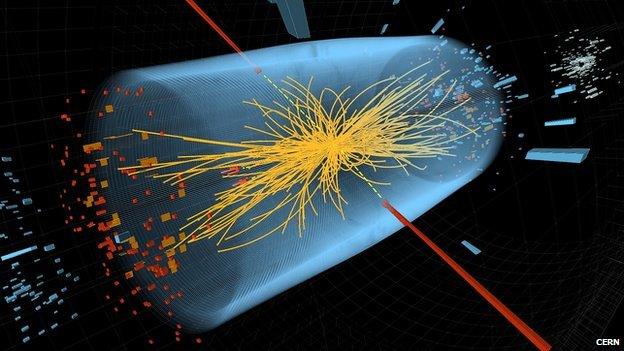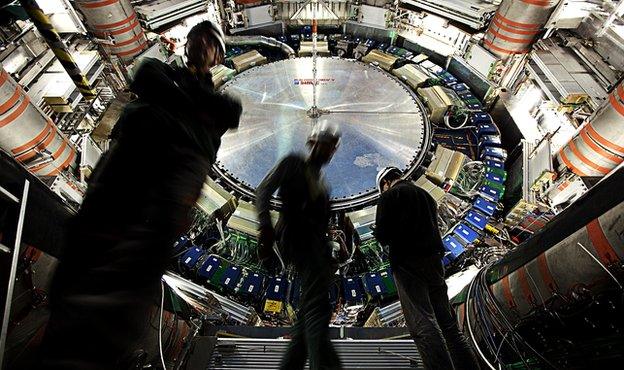Excitement builds over Higgs data
- Published

Two teams working at the LHC have seen hints of what may prove to be the Higgs
Excitement is building ahead of a conference to be held in Melbourne, Australia, in July where scientists are expected to present new findings in their search for the Higgs boson.
But a definitive statement on its existence will probably have to wait - at the very least until the Autumn.
Nevertheless, a 30-year search for this vital missing building block of the Universe is entering its endgame.
The Higgs is the most coveted prize in particle physics.
It is the cornerstone of the Standard Model - the most successful theory for describing how the Universe works - and explains why all other particles have mass.
In December, scientists at Cern, the organisation which operates the Large Hadron Collider (LHC), told the world they had possibly "glimpsed" the elusive particle.
But scientists had to stop short of announcing a discovery; their tentative signal did not meet the benchmark required for a formal discovery. This threshold is a level of statistical certainty known as "five sigma".
A five sigma result means there is a one in 1,000,000 chance that a "bump" in the data (the possible signal of a new particle) is just a fluke.
The LHC rumbled back to life in April with little fanfare following its regular winter shutdown to save on electricity costs. After something of a slow start, it has begun to collide particles at a higher energy than ever before.
Not only has it received a hike in energy, from 3.5 trillion electronvolts (TeV) to 4 TeV, but also luminosity (this is a measure of the number of collisions that are possible per second and per cm squared).
The latter in particular has been important for boosting data collection: the collider has already gathered slightly more data in the last few months as it did during the whole of 2011.
Physicists have been hard at work crunching the numbers and are set to give an update to the Cern Council, which meets on Thursday and Friday. They then plan to present results at the International Conference on High Energy Physics (ICHEP), external in Melbourne, which runs 4-11 July.
"There are three things that can happen," says Dr James Gillies, director of communications at Cern, "[The signal has] gone down in significance, it has gone up in significance - but not to the point where physicists can claim a discovery - or thirdly, that there's a discovery."
Two experiments at the LHC - Atlas and CMS - are searching for the Higgs independently and will present their findings separately. Scientific groups both within and between the collaborations are not supposed to talk to each other about their findings, thus preventing "cross contamination" of results.
In some instances, one experiment might observe something that the other does not, as happened at the US Tevatron particle smasher last year. However, if both experiments see a signal in the same part of the "search area" - as Atlas and CMS did in December - it becomes more likely that they are observing something tangible, rather than a statistical fluctuation.
Once they have presented their results, they can be combined on one graph. If the results from Atlas or CMS fall short of the five sigma level, the combination could push the statistical significance over the discovery threshold.
Combined results won't be available by the time of ICHEP. But, says Dr Gillies, "people who are not involved in the analyses directly won't be able to resist the temptation to say 'look, if you put these together, you get this result'."
"I don't know what's in the data yet, but there's a lot of excitement about what might be there."
It is no surprise that the blogosphere is rife with rumours. At the blog Not Even Wrong, external, Peter Woit says scientists analysing the 2012 data observe a signal in the same place - a mass of 125 Gigaelectronvolts (GeV) - as they did in December, at least for a Higgs decaying into two photons.
Scientists cannnot detect the Higgs directly; if the particle is generated by smashing protons together in the LHC, they will have to infer its existence by looking at the particles it has ultimately decayed - or transformed - into, and work backwards to "reconstruct" it.
Woit writes that the certainty level has crept up and says the fact both Atlas and CMS observe a signal in the new data strengthens the significance of the result. However, Cern officials will not comment on rumours and stress that analyses are ongoing.
Other physicists believe a five sigma result is highly unlikely to be announced at the ICHEP conference.
Prof Dave Charlton, from the Atlas collaboration, cautions: "One shouldn't get too excited about what's going to happen… at ICHEP. The amount of data we'll have collected and expect to be able to present is similar to what we collected last year. So we should get a lot more information, but strange things can happen with low statistics.
He adds: "[The data] comes in more or less continuously over the year. We'll take one snapshot in July at the ICHEP conference in Melbourne, then there'll be another snapshot in mid-September. And then another towards the end of the year. The evidence will evolve between those three sets of results and we don't know how it will evolve.
"We have this whole year's worth of data to take. And when we have that full data sample, which will be towards the end of [2012], that's the timescale on which we will have the really clear picture."
If one assumes the signal from 2011 does not vanish, and eventually exceeds the five-sigma threshold, physicists will then begin the process of understanding what they have found.

It will take years of work to characterise the Higgs, if indeed the particle is found
They will want to know whether the new particle fits the version of the Higgs envisaged by the Standard Model, or whether its properties hint at some new physics.
That will involve years of detailed and difficult work, says Dr Tony Weidberg, from the University of Oxford. He told BBC News that even at a certainty level of five sigma "you're very far from proving it's a Higgs particle at all, let alone a Standard Model Higgs".
He adds: "If the most plausible hypothesis is that it's a Standard Model Higgs, you have to ask 'what experiments can we do to test that hypothesis'. The answer is to measure as much detail as you can about this particle. It's much harder to do these detailed measurements than just see if there is something there."
There is much the Standard Model cannot explain - gravity for example, or the dark matter and dark energy that together make up most of our Universe. This framework is now seen as a stepping stone to something more significant - a theory of everything.
"If we find something it could either be a bog-standard Standard Model Higgs boson, which would be very nice but would not give us any pointers on where to go next," says Dr Gillies. "Or it could be an incarnation of the Higgs which is linked to supersymmetry or extra dimensions theory."
Unseen Universe
Most physicists will hope it is the latter, he explains, "just in terms of getting us to the 96% of the Universe the Standard Model doesn't cover".
Dr Gillies adds: "By measuring all the parameters and decays accurately and precisely we will be able to establish what kind of Higgs it is."
Tony Weidberg says: "The Higgs is responsible for generating mass in the theory, so it couples more strongly to heavier particles than to lighter ones. That's a very characteristic feature."
Such a particle could be further characterised by studying the ways in which it decays into other particles, the different ways in which it is produced and also the rates at which it is produced.
For example, the teams can measure the ratios of various final states after the Higgs has decayed into other particles. These ratios can then be compared against the predictions of the Standard Model.
Mre subtle measurements would require the LHC to generate much more luminosity; the machine is expected to increase this property through a series of upgrades over the next 10 years.
- Published5 April 2012
- Published7 March 2012
- Published13 December 2011
- Published4 July 2012
- Published12 December 2011
- Published1 December 2011